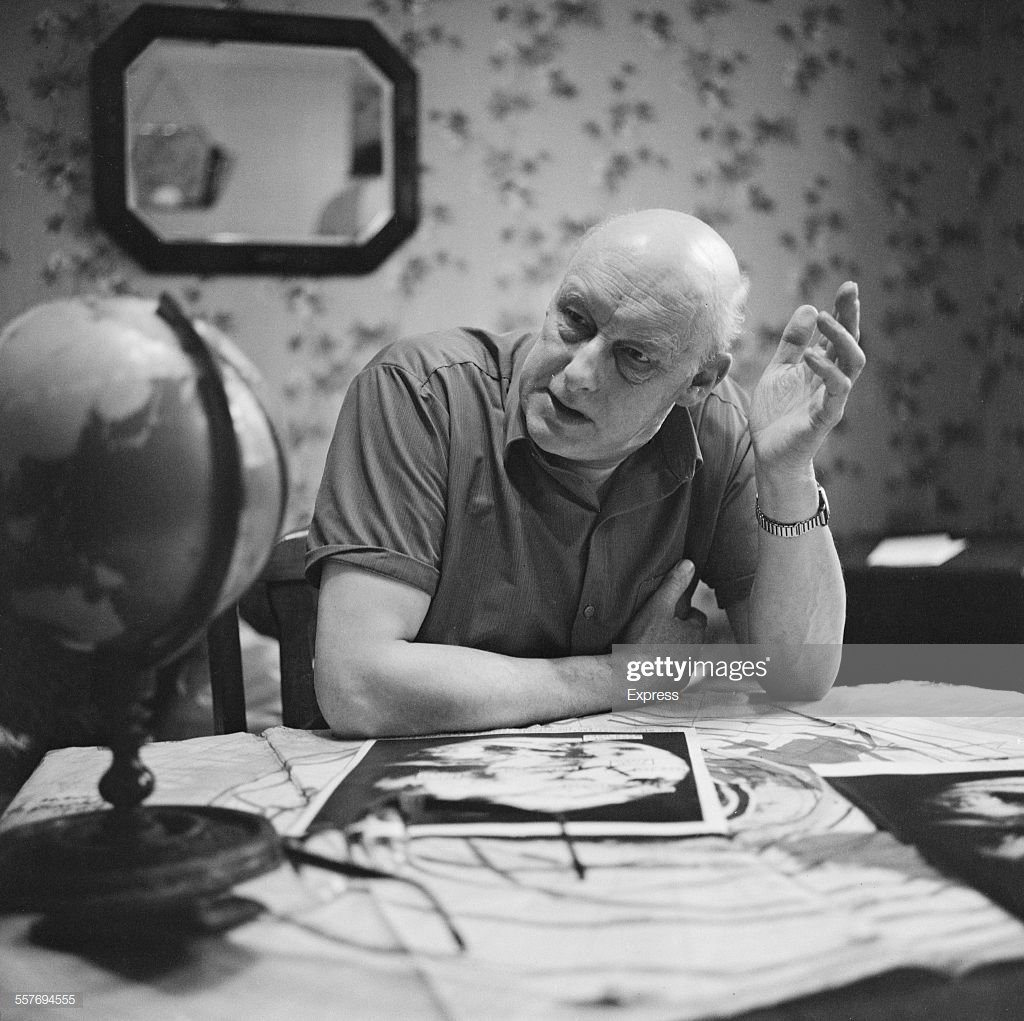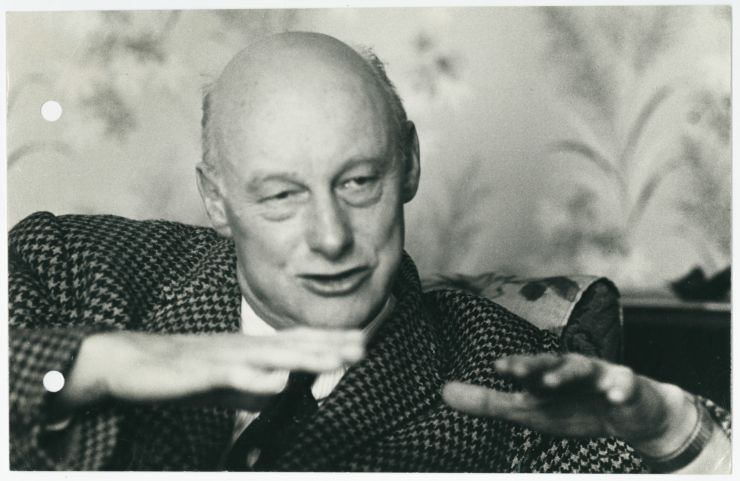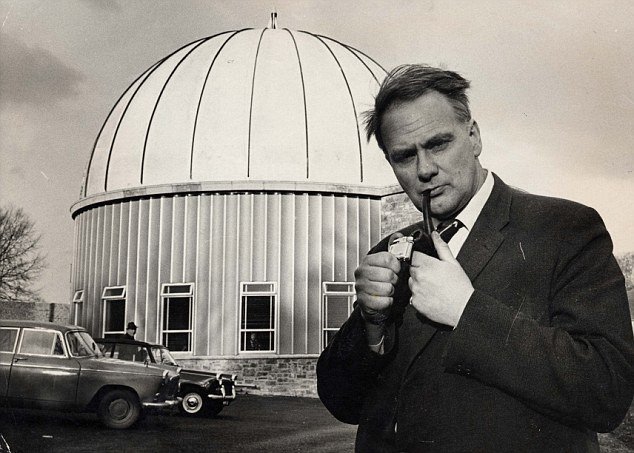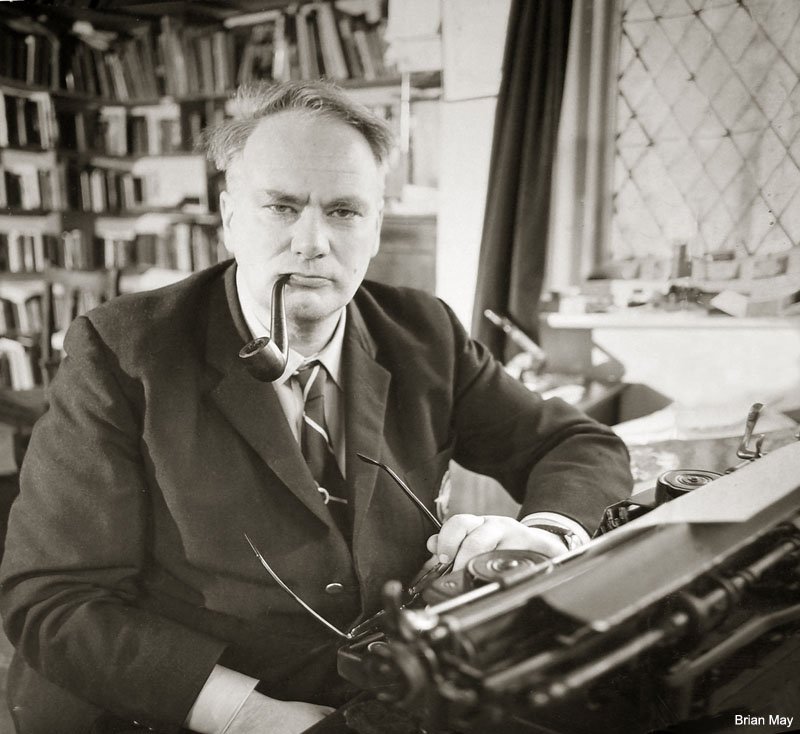DARKEST HOUR | Samuel Shenton, Flat Earth, and the Genesis Cloak of Deception
1
AWAITING COLONEL JOHN GLENN’S RETURN TO EARTH was a handwritten message which simply read:
OK, wise guy.
Its author was none other than Samuel Shenton, world renowned and globally reviled flat earthist. In light of the three orbits which Glenn is claimed to have completed on the 20th of February 1962, the space race was perhaps his darkest hour—particularly for those few remaining souls who still retained a faith in God’s Testimony to His own creation. This was the decade in which flat earthists Mark Sargent, Patricia Steere, Bob Knodel, David Weiss, Chris Van Matre, and Rob Skiba were born. Robbie Davidson, Rick Hummer, and Shelley Lewis would follow along shortly thereafter, and before the Apollo missions were over. But their voices would not be heard for nearly another half century.
At present, Shenton alone held the torch.
For this he was scorned and ridiculed, in part because the press tugged at his enthusiastic and rather childlike heart strings. Theirs was an archeological artifact dangled for the self-flagellating reader, and yet which the vast majority of Americans, caught in the current of Cold War Science, simply wanted buried. The strain was simply too much for him—the hour seemingly too dark. Shenton’s conviction drained him financially and emotionally at a cost to his own health. He would suffer two strokes in 1963. The second left him with distorted vision—a disaster for his signwriting business. And in March of 1971, Shenton would not live to see the Apollo program he vehemently sought to prove as a series of elaborate hoaxes come to a close.
Shenton died 68 years young.
2
“The World… the whole, self-poisoned lost is at the most critically, foretold condition it is possible for ‘The Watchers’ as ourselves to ever contemplate.”
Samuel Shenton
18 February, 1970
ATTENDING SAMUEL SHENTON’S FIRST GATHERING of flat earthists was British astronomer Patrick Moore, host of BBC’s The Sky at Night. Shenton had founded the International Flat Earth Research Society in 1956 as a direct descendant of Lady Elizabeth Blount’s Universal Zetetic Society. A president was immediately established in William Mills, relative of one of Lady Blount’s closest followers, Frederick Cook. The legacy of Blount and the flat earthists who associated with her and the paper which she edited—The Earth Is Not a Globe Review—formerly commenced in the living room of Mills Finsbury Park home, where every cushion of furniture was reportedly filled. The eminent Copernican astronomer later recounted leaving that meeting “in a mood of deep thought.”
Memories of that meeting had clearly not escape Moore, some thirteen years later, when he opened a monthly episode of One Pair of Eyes, titled, Can You Speak Venusian, to boast of the letters he’d received from “people of independent thought; people who weren’t shackled by the strings of convention.” To this he quickly added, “I believe, you know, they’re all nowadays too conventional and too regimented. We believe what we’re told and we believe as we are told.” Here-in lays the premise of his program. Moore wanted to examine the alternative views of individuals who were not shackled by conventional thinking—who were quite prepared to go out on a limb and think for themselves.
Within moments of the program, having already met with a group of rambunctious, snowball pelting school boys (they’d apparently slopped a round down his neck before the camera happened to catch the crime) to challenge them as to their own unquestioning belief in gravity, Moore kindly confessed: “There is a danger that we’re going to turn into regimented sheep if we accept too much—or have we already done it? And I very much fear that I’m one of these sheep…” One such letter, which he possessed in his keeping, originated from the gentleman whose meeting he had attended some thirteen years earlier. Shenton, he says, “believes the earth is shaped like a gramophone record, with the North Pole in the middle and the wall of ice all around the edge.”
Seated in the home of the world’s flat earthist spokesman, maps, illustrations, and diagrams spread out before them on his table, Shenton seems completely unconcerned that the episode in question was filmed in the wake of the Apollo 8 mission, the first crewed spacecraft to reportedly leave low earth orbit, reach the moon, circumnavigate it, and then return. That’s not to say that thirteen brutal years of the space race hasn’t taken its toll. If anything, he comes across to his viewers as a tired old man obstinately clinging to a failed position. When the International Flat Earth Research Society was conceived in William Mills’ living room, space travel itself had yet to be achieved, and such bold blanketed statements, that Scripture itself informed his beliefs, were (how do we say it?) less of a gamble. There was indeed a time when space travel was little more than a genre of science fiction. At that meeting in 56, Shenton himself quipped: “Would sailing around the Isle of Wright prove that it were spherical?” And yet, in as little as a year, the Russians were determined to change that.
Though ailing of health and short of breath, Shenton clearly isn’t shaken at the fact that it would also first air on the 10th of May 1969, only weeks before the Apollo 11 moon landing. When speaking of earth’s origin, the waters, Shenton insisted, “were dispelled from the earth, and the whole thing was covered by a heaved-up structure, Shamayim in the Hebrew—a heaved-up structure actually in water.”
Moore quickly asks: “What about the astronauts then, if they didn’t in fact go around the earth, what did they go around?”
The astronauts simply “fired off from Cape Canaveral,” Shenton replies, “and went on an egg-shaped orbit” around the plane of the earth.
“Keeping the same height all the time?” Moore asks.
“Absolutely, sir,” Shenton speaks with generosity and kindness, giving absolutely no hint as to the innumerable correspondences he’d received from misanthropists over the last decade and a half. Orbit is nothing more than carrying a rocket up to a certain height and then leveling off.
Like a gramophone record.

3
DESPITE THE ASTRONOMER’S CHARITABLE WORDS, a likely few shared his sympathy—and an even smaller rotunda of the Christian faithful clung to Samuel Shenton’s dog-like loyalties. Sure, Glenn received letters. Moore did too. But with the Mercury missions captivating worldwide audiences, Shenton began receiving his own fair share of them—lots of letters. Actually, they started pouring in—upwards of 40 per day. But unlike America’s paraded space heroes, the stamps postmarked to Shenton were rarely licked with pleasantry. Among the morally outraged correspondences addressed to Shenton, typical arguments included ships disappearing over the sea’s horizon, as the Alexandrian’s had once proven, Earth’s circular shadow on the moon, and Jupiter and Saturn’s globular appeal.
Dated September 20, 1965, only one month after NASA’s launch of Gemini 5, a New York man wrote:
Dear Mr. Shenton,
“You are a nut. NUT – N-U-T – NUT. If the world is flat, why hasn’t anyone fallen off? Maybe your organization is a farce, but if you seriously believe what you state, you, dear sir, are crazy.”
In closing, the New Yorker added: “When you get this letter, it will have traveled 3,000 miles over a curved surface.”
On October 4 of that same year, a North Carolina man wrote:
“All I can say is this is the most imbecilic misconception of the Dark Ages that has existed to this modern day. You, a mature man (physically, if not mentally) rejecting all scientific proofs to support a belief that has not been accepted for many centuries. I am including…a photograph of the Earth taken from the moon by the American Lunar Orbiter. Try to explain that into a flat plane without sounding foolish.”
Children and teenagers were likewise full of reproach. Likely fresh from the playground, a boy from Brooklyn wrote:
“Why do you think the world is flat? I think the world is round. Your people think the world is flat. But it is not flat. I can prove it… The people in Brooklyn knows that the world is round. They can prove it to. Because we have round globes. Why do you think the world is flat? If you come out here everybody will know that your people think the world is flat. Someone should show you that the world is round. Did you see the pictures that the spacemen took of the Earth? Didn’t you see the pictures on TV?”
In her book, Flat Earth: The History of an Infamous Idea, Christine Garwood writes: “Despite the point that, in all likelihood, many of Shenton’s correspondents could not identify how they initially knew the earth was a globe, or could not build a convincing case that it was, except by reference to cultural representations of nature, they could not accept, and were sometimes disturbed or offended by, Shenton’s refusal to abide by commonly held standards of authoritative proof.” Accordingly, it was unthinkable that the Bible should be employed to add weight to the activities of “infidel science.” Shenton spoke of a transparent moon some 32 miles in diameter, completely snubbing the official estimate of 2160 miles; a self-illuminating body which floated in the sky a mere 2,550 miles away. The flat earth was a profound metaphysical issue backed by the Word of God, one which struck at the heart of a war between Science and the Bible.

Shenton however was not much of a writer. Speaking was his forte, with political groups, reading circles, church associations, and youth clubs occupying his peripheral vision. He turned down interviews with Playboy on the grounds that its pages “smelled of Gomorrah,” and refused the far-out underground magazine Oz, despite their common anti-establishment stances. Contrarily, the flat earthist infrequently declined an invitation to lecture or debate, and was certainly not a stranger to the Universities of Oxford and Cambridge and the Young Scientist Club. His activities quickly garnished the Media’s gaze.
Throughout the space race, mocking headlines would read: “Enoch Sends Flat-Earth Men Round the Bend.” In turn, Cold War Americans—who preferred the pomp and circumstance of glittering parades—fell in easy cadence with their propaganda. So imagine their initial disappointment to find in Shenton an average blue collar worker—specifically, a sign writer by trade—who lived simply with his wife in a ginger-brick terrace in the suburbs of Dover. The media had no doubt hoped to digest as their main course an eccentric provocateur, but what they found was an amiable soul; a balding Englishman who habitually wore woolly-pullovers, red carpet slippers, and enjoyed studying maps.
Shenton’s troubles began in October of 1957, when Sputnik 1 streaked across starry skies. And yet Shenton refused to budge. Sputnik, he contended, was just like a marble “spinning round a saucer.” This so-called orbit, Shenton assured his followers, was nothing more than a cheap parlor trick. Soviet Yugi Gagarin had simply circled the earth, he said, “like a needle on a record.”
Only two months later—in December of that year—William Mills, president of the International Flat Earth Research Society, died. For the following decade the IFERS would prove costly and time consuming for its founder. Regardless, a determined Shenton subsided costs from his own pocket and had little choice but to run the operation from his Dover house. It is there where he would brave the seemingly infinite gloom of the space race alone, and eventually, as his age deepened with the persistent offensive of America’s Apollo Missions, he would brave it from his bedroom.
After Alan Shepherd became the first American in space on May 5, 1961 aboard his Mercury spacecraft Freedom 7, Shenton informed the media that such a feat was impossible on the basis that there was no such thing as orbit to begin with. To this effect he said: “Humanity has been brainwashed into accepting round earth theory.”
In 1966 Shenton produced a pamphlet for members of IFERS, The Plane Truth, which stated, in no uncertain terms, “that modern astronomy and space flight were insults to God and divine punishment for humankind’s arrogance was a mere matter of time.”
Shenton was apparently a glutton for punishment, because he readily denounced the August 1967 Lunar Orbiter’s photograph of the earth, reportedly taken from 214,806 miles in distant space, a “fraud, fake, trickery, or deceit, just like that.” He furthermore called attention to suspicious lines and ragged edges, maintaining that it was just a “composite picture,” or mock-up, which any of their photographer chaps could have managed with ease. When asked by a reporter at the Sun why anyone would want to perpetrate such a deception, Shenton replied, this “great Global Earth Conspiracy” was motivated “by the desire to deny God as the Creator of all things.”
As if he had yet to take a single swing to the hornets’ nest with a bat, he furthermore noted, the plot had been perpetuated by our worst enemies. No, not the Soviet’s, Americans, nor the Brits, but “persons and schoolmasters, the idle shepherds” mentioned in the Bible. Those tasked with the safekeeping of Christ’s flock were to blame. They were hirelings. Clearly, the wolves had come in.
Shenton did not shy from insulting the Christian’s ongoing worship of intelligence. He claimed that schools, colleges and universities were a “media of mass brain conditioning;” a cesspool where the “unproven, godless, globular theory” festered. By simply rejecting the space flight narrative—and daring to go it alone—Shenton was humbly asking his fellow Christians to choose God’s Testimony concerning His creation rather than the adulterous patriotism which had hijacked the good faith and served as a counterfeit façade for the true saving religion. Shenton was bold enough to tell the world’s press that orbital space flight was nothing more than an illusion. “Gagarin, Glenn and Company,” he said, “had circled over a flat surface like a toy airplane on the end of a piece of string.”
After the Apollo 8 capsule returned in 1968 with pictures from space, Shenton bolstered his own rhetoric. In a reply to the Guardian, Shenton insisted that those who studied the Bible knew the earth was flat and were aware that Christ himself had warned of a “great deception which might shake the frail Christian faith.” Though NASA astronauts circulated photographs depicting the Earth as a planet, their technological villainy had been worsened by their exploitation of “the opening verses of Genesis…as a deceptive cloak.” Those who understood Scripture knew the truth, that Science was propagating a lie. “That is why,” Shenton concluded, “there will always be a Christian opposition to godless men who parade man’s thoughts as science.”
Even Christine Garwood confirmed what the Bible’s authors thought and taught when she wrote of Hebrew Cosmology:
“…the cosmos consists of the vault of heaven (shamayim), or ‘firmament,’ containing the sun, moon and stars (genesis 1:14-17). The Bible teaches that these heavenly bodies move across the stationary earth (Psalms 19:1-7), while the firmament rests on pillars or mountains (Job 26:11) rooted in the flat earth below. Beneath the earth lies the underworld, Sheol, seen as the abode of the dead (Numbers 16:28-34; I Samuel 28:13-15; Isaiah 14:9-11; Ecclesiastes 9:19). The earth, which is generally depicted as an immovable disc or ‘circle’ (Job 26:7), is bordered by a protective barrier, probably a mountain range. As for its shape, it is generally spoken of as a flat disc, so that if one traveled far enough one would eventually arrive at the ‘ends of the earth’ (Deuteronomy 13:8, 28:64; Isaiah 5:26; Psalm 135:7). Within this scheme, the four corners of the earth (Isaiah 11:12, Ezekiel 7:2) might refer to distant regions, unless taken literally, when the earth could be considered rectangular or square.”
Christine Garwood, aptly recognizing what the Hebrews actually believed, has sided with the Greeks; and dare I say the sorcerers of Babylon—those who would turn the opening pages of Genesis into a deceptive cloak. That is one thing for Garwood, who makes no passing mention of her salvation, but what of the believer? Shenton stood with the chapped lips and the hoarse throats of the Spirit-filled Prophets, Psalmists, and Apostles. Most importantly, he stood with [YHWH] YAHUAH, THE MOST-HIGH ELOHIM, and His Son, Yahusha, Savior of the World, who confirmed all Scripture as truth.
And for the most part, Shenton stood alone.
As of 1969, IFERS had dropped to 100 members worldwide. How many members simply subscribed to glean information from him, so as to have a good laugh, is unknown. Not even its own president, the Greater London Council and North East London Polytechnic lecturer Ellis Hillman, believed the earth to be flat.
Shenton did not have our framework of knowledge today. He could not have possibly connected all the dots between the Mystery Babylon religion of old with the Occult of present. He likely paid Aleister Crowley and his kindred no mind, nor founder of JPL, Jack Parsons—and quite certainly had no knowledge of the Russian Cosmists and little else that had transpired beyond the iron curtain. I therefore ask my reader to choose his side. Over there among the spirited bands, gaily marching to the tune of Stars and Stripes Forever, we find the Greek philosophers, the Platonists, and the Occulting Mysteries, from whence they derived, masterfully manipulating the heartstrings of America’s national pride. And quite contrarily, we have the Prophet Isaiah, who wrote of the Babylonian religion and such a time as this.
“And thou saidst, I shall be a lady forever: so that thou didst not lay these things to thy heart, neither didst remember the latter end of it. Therefore hear now this, thou that art given to pleasures, that dwellest carelessly, that sayest in thine heart, I am, and none else beside me; I shall not sit as a widow, neither shall I know the loss of children: But these two things shall come to thee in a moment in one day, the loss of children, and widowhood: they shall come upon thee in their perfection for the multitude of they sorceries, and for the great abundance of thine enchantments. For thou hast trusted in they wickedness: thou hast said, None seeth me. Thy wisdom and they knowledge, it hath perverted thee; and thou hast said in thine heart, I am, and none else beside me. Therefore shall evil come upon thee; thou shalt not be able to put it off: and desolation shall come upon thee suddenly, which thou shalt not know.”
Isaiah 47:7-11
With the Apollo 11 moon landing, Shenton succumbed to bad health. The very summer of his televised meeting with Moore, Shenton collapsed. For the remainder of his life, he was confined to running the society from his bedroom. By Christmas 1969, Shenton had been in his sick room for three months, but still managed to “straddle a typewriter across his body.” He used it mainly to reply to his correspondences, one in which he confessed that he had “not been to bed for about a year.” It was a life “spent propped up between chairs” while “whacking great ulcers down each shinbone” had prevented him from “sleeping, thinking, or reading.” Even worse, he wrote, their “vile stench and the weeping makes me wish to hide away; had it not been for my wife’s constant attention, I don’t think I could have stuck it!”
His condition further deteriorated over the opening winter months of 1971. Shenton died in a Folkestone hospital on 2 March, 1971, at the age of sixty-eight due to cardiac failure and hypertensive heart disease, a condition doubtless exacerbated by the strain of persistent campaigning to pull the whole “self-poisoned world” of science, as he called it, from the classroom of every age.
Thank you, Samuel Shenton, for going it alone in our darkest hour.
4
SIR PATRICK MOORE DIED on December 9, 2012 at 89 years of age. A flat earthist such as myself can only wish and wonder, had he stuck around but another three years, to hear about these flat earthists running amuck. I can imagine him in bed, frailly attempting to hold his composure while grumbling miserably and, dare I say it, smiling softly:
It’s Samuel Shenton all over again.
Only this time—this time there’s hundreds of thousands of them.
Noel

